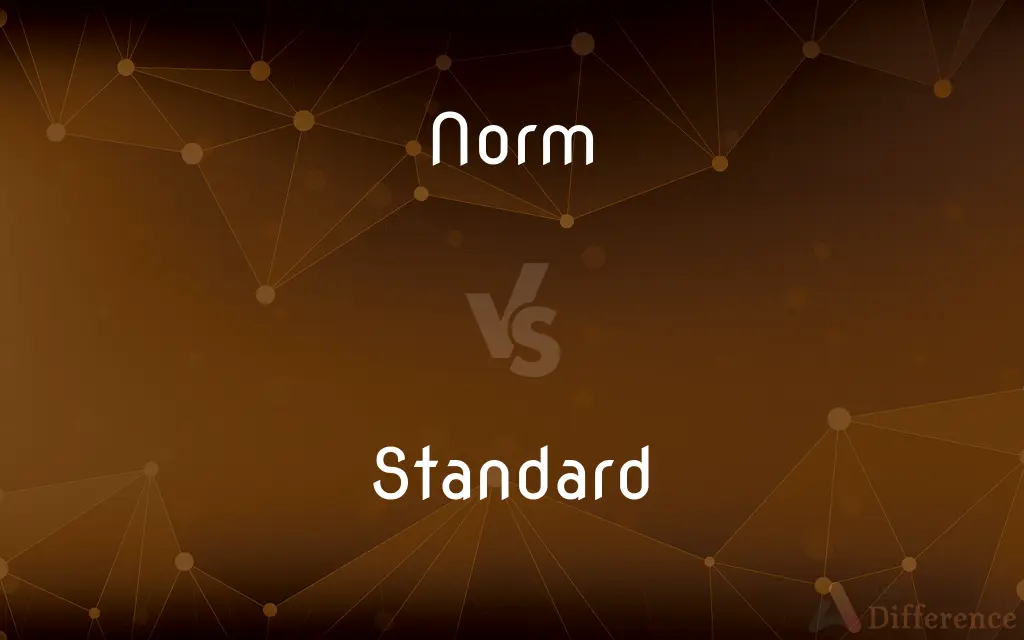Norm vs. Standard — What's the Difference?
By Tayyaba Rehman — Updated on October 12, 2023
A norm is an accepted behavior within a group or society, while a standard is a set criterion or measure against which things are compared or assessed.

Difference Between Norm and Standard
Table of Contents
ADVERTISEMENT
Key Differences
A norm generally refers to an unwritten rule or expectation about behavior in a specific group or society. For example, waiting in line patiently is a social norm in many cultures. Conversely, a standard is more about a specific and often documented benchmark, measure, or criteria. When we refer to a "gold standard," we are pointing towards a definitive level of excellence in a certain field.
Norms, while influential, often derive from collective behaviors, cultural values, or societal conventions. Breaking a norm might lead to social disapproval or misunderstandings. In contrast, standards typically arise from authoritative bodies, organizations, or experts. Failing to meet a standard might lead to more concrete consequences, like a product being rejected.
The idea of a norm often suggests that there is a general consensus on a behavior, yet it can change over time as society evolves. For instance, norms around fashion or communication styles shift with generations. Standards, on the other hand, tend to be more consistent, although they can be updated. For example, industry standards may evolve based on technological advancements.
While both norms and standards can be internalized and guide actions, norms often operate on a more subconscious level. One might adhere to a social norm without active thought. However, standards typically require a more deliberate effort to understand and follow, especially in professional settings.
Norms and standards can overlap in some contexts. For instance, in professions like medicine or engineering, ethical norms might align closely with professional standards. While the norm might be the ethical guideline that professionals believe in, the standard could be the concrete rules they need to adhere to.
ADVERTISEMENT
Comparison Chart
Origin
Arises from collective behaviors, cultural values, or societal conventions
Often set by authoritative bodies or experts
Flexibility
Can change over time and varies among cultures
More consistent, though can be updated
Documentation
Typically unwritten
Typically documented
Consequence
Social disapproval or misunderstandings
More concrete consequences, e.g., product rejection
Purpose
Guides behavior based on collective expectations
Serves as a benchmark or criteria for comparison/assessment
Compare with Definitions
Norm
A standard or pattern that is typical or expected.
The norm for students is to graduate in four years.
Standard
A rule or principle that is used as a basis for judgment.
They failed to meet the basic safety standards.
Norm
A social standard that represents the most common behavior.
In many cultures, it's the norm to greet with a handshake.
Standard
An authoritative statement that serves as a guideline or benchmark.
The document outlines the standard procedures to follow.
Norm
An accepted behavior or procedure in a group or society.
Wearing formal attire to a job interview is the norm in many industries.
Standard
A level of quality or attainment
The government's ambition to raise standards in schools
Their restaurant offers a high standard of service
Norm
A principle of right action binding upon the members of a group.
Honesty is a fundamental norm in many cultures.
Standard
Something used as a measure, norm, or model in comparative evaluations
The wages are low by today's standards
The system had become an industry standard
Norm
A set point of reference in statistical data.
The test results were compared to the national norm.
Standard
(especially with reference to jazz or blues) a tune or song of established popularity.
Norm
Something that is usual, typical, or standard
Strikes were the norm
Standard
A military or ceremonial flag carried on a pole or hoisted on a rope.
Norm
The product of a complex number and its conjugate, equal to the sum of the squares of its real and imaginary components, or the positive square root of this sum.
Standard
A tree or shrub that grows on an erect stem of full height.
Norm
Adjust (something) to conform to a norm.
Standard
An upright water or gas pipe.
Norm
A pattern that is regarded as typical of something
A neighborhood where families with two wage-earners are the norm.
Standard
Used or accepted as normal or average
It is standard practice in museums to register objects as they are acquired
The standard rate of income tax
Norm
A standard or expectation that is established for a given enterprise or effort
Journalistic norms.
Standard
(of a tree or shrub) growing on an erect stem of full height
Standard trees are useful for situations where immediate height is needed
Norm
A pattern of behavior considered acceptable or proper by a social group
Violated the norms of his community.
Standard
Serving as or conforming to an established or accepted measurement or value
A standard unit of volume.
Norm
An average.
Standard
Widely recognized or employed as a model of authority or excellence
A standard reference work.
Norm
The magnitude of a vector.
Standard
Acceptable but of less than top quality
A standard grade of beef.
Norm
The modulus of a complex number.
Standard
Normal, familiar, or usual
The standard excuse.
Norm
To establish or judge in reference to a norm
Normed the test on the basis of last year's results.
Standard
Commonly used or supplied
Standard car equipment.
Norm
(Mathematics) To define a norm on (a space).
Standard
(Linguistics) Conforming to models or norms of usage admired by educated speakers and writers
Standard pronunciation.
Norm
That which is normal or typical.
Unemployment is the norm in this part of the country.
Standard
An acknowledged measure of comparison for quantitative or qualitative value; a criterion.
Norm
A rule that is imposed by regulations and/or socially enforced by members of a community.
Not eating your children is just one of those societal norms.
Standard
An object that under specified conditions defines, represents, or records the magnitude of a unit.
Norm
A sentence with non-descriptive meaning, such as a command, permission, or prohibition.
Standard
The commodity or commodities used to back a monetary system.
Norm
(mathematics) A function, generally denoted or , that maps vectors to non-negative scalars and has the following properties: Category:en:Functions
Standard
The set proportion by weight of gold or silver to alloy metal prescribed for use in coinage.
Norm
If then ;
Standard
A degree or level of requirement, excellence, or attainment
Their quality of work exceeds the standards set for the field.
Norm
Given a scalar , , where is the absolute value of ;
Standard
Something, such as a practice or a product, that is widely recognized or employed, especially because of its excellence.
Norm
Given two vectors , (the triangle inequality).
Standard
A set of specifications that are adopted within an industry to allow compatibility between products.
Norm
(chess) A high level of performance in a chess tournament, several of which are required for a player to receive a title.
Standard
A requirement of moral conduct
The standards of polite society.
Norm
(analysis) To endow (a vector space, etc.) with a norm.
Standard
The ensign of a chief of state, nation, or city.
Norm
A rule or authoritative standard; a model; a type; as, deviations from the norm are not tolerated.
Standard
A long, tapering flag bearing heraldic devices distinctive of a person or corporation.
Norm
A typical, structural unit; a type.
Standard
An emblem or flag of an army, raised on a pole to indicate the rallying point in battle.
Norm
A standard or model or pattern regarded as typical;
The current middle-class norm of two children per family
Standard
The colors of a mounted or motorized military unit.
Norm
A statistic describing the location of a distribution;
It set the norm for American homes
Standard
Chiefly British A grade level in elementary schools.
Standard
A pedestal, stand, or base.
Standard
The large upper petal of the flower of a pea or related plant. Also called banner, vexillum.
Standard
One of the narrow upright petals of an iris.
Standard
A shrub or small tree that through grafting or training has a single stem of limited height with a crown of leaves and flowers at its apex.
Standard
(Music) A composition that is continually used in repertoires
A pianist who knew dozens of Broadway standards.
Standard
Falling within an accepted range of size, amount, power, quality, etc.
Standard
(of a tree or shrub) Growing alone as a free-standing plant; not trained on a post etc.
Standard
Having recognized excellence or authority.
Standard works in history; standard authors
Standard
Of a usable or serviceable grade or quality.
Standard
Having a manual transmission.
Standard
As normally supplied (not optional).
Standard
(linguistics) Conforming to the standard variety.
Standard
A principle or example or measure used for comparison.
Standard
A level of quality or attainment.
Standard
Something used as a measure for comparative evaluations; a model.
Standard
A musical work of established popularity.
Standard
A rule or set of rules or requirements which are widely agreed upon or imposed by government.
Standard
The proportion of weights of fine metal and alloy established for coinage.
Standard
(sociolinguistics) standard idiom, a prestigious or standardized language variety; standard language
Standard
A bottle of wine containing 0.750 liters of fluid.
Standard
(India) Grade level in primary education.
I am in fifth standard.
Standard
A vertical pole with something at its apex.
Standard
An object supported in an upright position, such as a lamp standard.
Standard
The flag or ensign carried by a military unit.
Standard
One of the upright members that supports the horizontal axis of a transit or theodolite.
Standard
Any upright support, such as one of the poles of a scaffold.
Standard
A sturdy, woody plant whose upright stem is used to graft a less hardy ornamental flowering plant on, rather then actually planting it.
Standard
A tree of natural size supported by its own stem, and not dwarfed by grafting on the stock of a smaller species nor trained upon a wall or trellis.
Standard
The sheth of a plough.
Standard
A manual transmission vehicle.
Standard
(botany) The upper petal or banner of a papilionaceous corolla.
Standard
(shipbuilding) An inverted knee timber placed upon the deck instead of beneath it, with its vertical branch turned upward from that which lies horizontally.
Standard
A large drinking cup.
Standard
(historical) A collar of mail protecting the neck.
Standard
(slang) An expression of agreement
Standard
A flag; colors; a banner; especially, a national or other ensign.
His armies, in the following day,On those fair plains their standards proud display.
Standard
That which is established by authority as a rule for the measure of quantity, extent, value, or quality; esp., the original specimen weight or measure sanctioned by government, as the standard pound, gallon, or yard.
Standard
That which is established as a rule or model by authority, custom, or general consent; criterion; test.
The court, which used to be the standard of propriety and correctness of speech.
A disposition to preserve, and an ability to improve, taken together, would be my standard of a statesman.
Standard
The proportion of weights of fine metal and alloy established by authority.
By the present standard of the coinage, sixty-two shillings is coined out of one pound weight of silver.
Standard
A tree of natural size supported by its own stem, and not dwarfed by grafting on the stock of a smaller species nor trained upon a wall or trellis.
In France part of their gardens is laid out for flowers, others for fruits; some standards, some against walls.
Standard
The upper petal or banner of a papilionaceous corolla.
Standard
An upright support, as one of the poles of a scaffold; any upright in framing.
Standard
An inverted knee timber placed upon the deck instead of beneath it, with its vertical branch turned upward from that which lies horizontally.
Standard
The sheth of a plow.
Standard
A large drinking cup.
Standard
Being, affording, or according with, a standard for comparison and judgment; as, standard time; standard weights and measures; a standard authority as to nautical terms; standard gold or silver.
Standard
Hence: Having a recognized and permanent value; as, standard works in history; standard authors.
Standard
Not supported by, or fastened to, a wall; as, standard fruit trees.
Standard
A basis for comparison; a reference point against which other things can be evaluated;
They set the measure for all subsequent work
Standard
The ideal in terms of which something can be judged;
They live by the standards of their community
Standard
A board measure = 1980 board feet
Standard
The value behind the money in a monetary system
Standard
An upright pole or beam (especially one used as a support);
Distance was marked by standards every mile
Lamps supported on standards provided illumination
Standard
Any distinctive flag
Standard
Conforming to or constituting a standard of measurement or value; or of the usual or regularized or accepted kind;
Windows of standard width
Standard sizes
The standard fixtures
Standard brands
Standard operating procedure
Standard
Commonly used or supplied;
Standard procedure
Standard car equipment
Standard
Established or widely recognized as a model of authority or excellence;
A standard reference work
Standard
Conforming to the established language usage of educated native speakers;
Standard English
Received standard English is sometimes called the King's English
Standard
Regularly and widely used or sold;
A standard size
A stock item
Standard
A level of quality or excellence that is accepted as the norm or by which actual attainments are judged.
The product meets the industry's highest standard.
Standard
An idea or thing used to measure, assess, or compare against.
The method is considered the gold standard in research.
Standard
A specific quantity or quality taken as a measure of magnitude.
The meter became the standard for length measurement.
Common Curiosities
What does a norm typically represent?
A norm typically represents an accepted behavior or expectation within a group or society.
Can norms change over time?
Yes, norms can evolve over time as society or group behaviors change.
Are standards consistent or do they evolve?
While standards are more consistent than norms, they can be updated based on advancements or new findings.
What are the consequences of not meeting a standard?
Failing to meet a standard can result in more concrete consequences, like product rejection or regulatory penalties.
How is a standard generally defined?
A standard is a set criterion or measure against which things are compared or assessed.
Do standards always require documentation?
While standards are typically documented, especially in professional settings, some informal standards might not be.
Who typically sets standards?
Standards are often set by authoritative bodies, organizations, or experts.
Are norms always documented?
No, norms are typically unwritten and arise from societal conventions or behaviors.
Are there instances where norms and standards overlap?
Yes, especially in professional settings where ethical norms might align with professional standards.
Are standards always industry-specific?
While many standards are industry-specific, some can be broader, applying across multiple domains.
What happens if someone breaks a norm?
Breaking a norm might lead to social disapproval or misunderstandings.
Is a norm always linked to societal behavior?
While many norms are linked to societal behavior, they can also exist within specific groups or communities.
Can something be both a norm and a standard?
Yes, especially when a behavior is both an accepted practice (norm) and has a set benchmark or criteria (standard).
Do norms have a global application?
No, norms can vary widely between cultures, societies, and groups.
How does one determine if something is a norm or standard?
By assessing its origin, documentation, consistency, and the consequences of not adhering to it.
Share Your Discovery

Previous Comparison
Steakette vs. Steak
Next Comparison
Pervy vs. PervertAuthor Spotlight
Written by
Tayyaba RehmanTayyaba Rehman is a distinguished writer, currently serving as a primary contributor to askdifference.com. As a researcher in semantics and etymology, Tayyaba's passion for the complexity of languages and their distinctions has found a perfect home on the platform. Tayyaba delves into the intricacies of language, distinguishing between commonly confused words and phrases, thereby providing clarity for readers worldwide.
















































